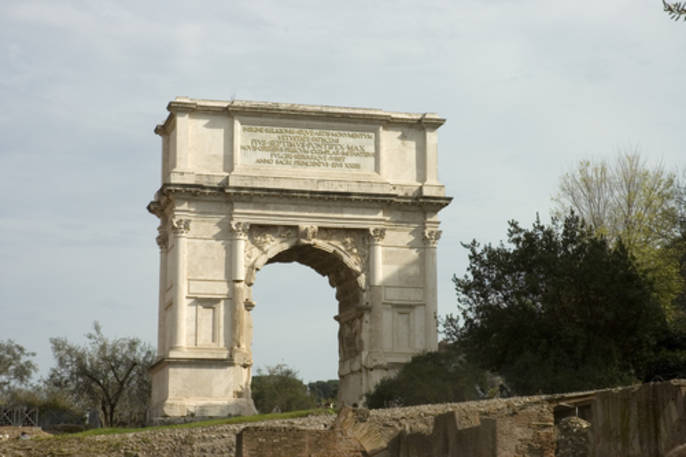


Arches, porches, magnificent white steps, Ionic columns, statues….
Columbia University [2], the prestigious campus in uptown New York City, owes a lot of its architecture and “Ivy League” charm to Greco-Roman culture, which has often set the standards for certain patterns and symbolic uses of Art in buildings and infrastructures.
It seemed particularly appropriate, then, to attend a lecture about architecture and Triumphant Art under the Flavian dynasty in Rome, as part of a series of events that aims to share these interesting topics not only with college students, but with the general public too.
The Italian Academy [3] is an important center for research, fellowships and studies promoting Italy, its culture, scholars and prominent figures, founded in 1991.
Its historical location, located within campus, is commonly known as “Casa Italiana”. Established in 1927, it’s an elegant and classy building on W 118th street.
It was there that Francesco De Angelis, Associate Professor of Roman Art and Archeology at Columbia gave an engaging lecture taking his audience on a virtual journey through famous monuments built during the time of the emperors Vespasian, Titus and Domitian.
Barbara Faedda, the Assistant Director of the Academy, was extremely enthusiastic about this event: “It relates really well with the Symposium we held about Rome’s Jewish Ghetto with Kenneth Stow (University of Haifa [4]) and Irina Oryshkevich (Columbia).”
She noticed how this year there is a particular attention, as it has somehow always been to Rome and its history in the New York cultural scene.
Allison Jeffrey, Assistant Director in Charge of Events announced the upcoming events of the program Italy at Columbia that in the past 3-4 years has involved several academics and general audience in the activities held at the Academy . On March 2nd, as an example, the Institution hosted the Symposium “Next Stop on the High Line: The Trento Tunnel” (Jeffrey Schnapp (Stanford Humanities Lab),
Elisabetta Terragni -CUNY, Kurt Forster- Yale) while on March 10th James Shapiro, Larry Miller Professor of English at Columbia
University, spoke about Shakespeare’s “Anthony and Cleopatra”.
Prof Francesco de Angelis' Lecture focused on the meaning and the importance of arches in the Flavian Architecture, between 69-96 C.E.
It’s fascinating, in fact, to see how monuments, on the surface so different and built centuries apart, like, for example, the St Louis’ Gateway to the West and the Arch of Titus in Rome, share similar meanings and significances: they are both a homage to territorial expansion, a celebration of success, triumph but not only. Arches are about brotherhood, opening doors and gateways, welcoming someone to a city, signifying a religious event.
The arch was indeed a very successful architectural motif in Rome - where there were more than 800 arches - as it is nowadays.
After the great Fire of 64 and the civil war of 69, a reconstruction program was promoted and put into action by Vespasian, who built for example some of the most famous monuments such as the Tempium Pacis.
The Arch of Titus, signified a “triumph”, a procession through which successful armies entered the city of Rome, walked through the Fori Romani and culminated on Capitol Hill. In this case the triumph was held after the victory in the Jewish War in Palestine, narrated by the famous historian Josephus Flavius.
The arch though was commemorative of this procession, since it was made much later after the death of Titus (82 C.E.). On the arch there is one of the few testimonies of the Temple in Jerusalem, the Holy Temple, that the Jews believe houses of God’s presence. Sacred objects like a seven branched menorah and trumpets can be seen. For many years the Roman Jews refused to walk under it, since it was associated with submission and only in 1948, with the founding of the State of Israel, the Jewish Community symbolically walked under it in the opposite direction to that taken by the ancient procession.
The Professor dwelled also on the depiction of Titus in a chariot accompanied by the goddesses Victoria and Roma.
Within the inscriptions, the frieze and its decorative sculptures lies the hidden power of this arch: the “quasi-cosmic meanings” of a military success now glorified, of human emperors now transformed into gods and divinified, are hidden in it.
The “tour” continued on with the Tempium Pacis, the Forum Transitorium, with its narrow structure surrounded by thin columns and with the Colosseum, otherwise known as the Flavian Amphitheatre, another monument partially financed by the capture of Jerusalem. The theatre was started by Vespasian, inaugurated by Titus and completed by Domitian.
The columns that support its arches represent all artistic styles: Tuscanic order (Doric), Ionic and there are two kinds of Corynthian.
As most people, in the Colosseum the audience could enjoy shows such as gladiator fights, public executions, mock naval battles, mythology ballets or animal hunts. However, the real spectacle was often given by the public itself, that actively interacted with the scene before its eyes. The theater could host an avarage of 50000-70000 spectators and its inaugural celebration lasted 100 days.
The lecture was clear and instructive, easy to appreciate and understand even for those who weren’t as familiar with the topic. This virtual tour left the audience fascinated by this crucial historical period and ready to learn more.
Source URL: http://newsite.iitaly.org/magazine/events/reports/article/triumphant-art-power-architecture-under-flavian-dynasty
Links
[1] http://newsite.iitaly.org/files/arch-titus-rome-ir0141268083603jpg
[2] http://www.columbia.edu/
[3] http://www.italianacademy.columbia.edu/
[4] http://www.haifa.ac